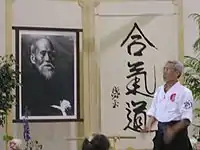
Mitsugi Saotome (五月女 貢, Saotome Mitsugi) (born in 1937) is a Japanese aikido teacher currently living in the United States.[1] He was a direct disciple of the founder of aikido, Morihei Ueshiba.[2]
Biography
At the age of 16, Mitsugi Saotome began his martial arts training in judo. At the age of 18, he entered the Aikikai Hombu Dojo in Tokyo in order to train under Ueshiba. Records provided personally from Kisshomaru Ueshiba, to the Saotome family from Hombu Dojo, detail a first degree black belt in 1957, and second degree black belt in 1958.[3] Kisshomaru Ueshiba goes on to confirm that Mitsugi Saotome became an uchi-deshi (personal apprentice or disciple) to Morihei Ueshiba in April 1959, receiving subsequent promotions to sixth degree black belt (Shihan) in January 1968, and remained uchi-deshi until the founder's death in April 1969.[3] Mitsugi Saotome trained at Hombu Dojo for a total of 15 years.[4][5]
He was very well respected as an instructor, receiving many honors. As a senior instructor in Aikido he was the Chief Weapons Instructor at Hombu. He held that position until 1975.[6]
At this time Saotome began to give great thought and contemplation as to his future purpose. After many days of consideration, he was said to have felt the hand of divine spiritual intervention. This was instrumental in his decision to relocate to the United States. He felt that the US was at a point of development that embraced new ideas, and that this would be an ideal environment to spread the message of peace and harmony implicit in the study of aikido.[7]
Saotome was asked about his decision to move to the US:
"I meditated on Ōsensei's spirit for three days and three nights and I felt it was his wish that I should go. This country is a great experiment, a melting pot of people from many different cultural backgrounds living together, the world condensed into one nation. The goal of aikido and Ōsensei's dream is that all the peoples of the world live together as one family, in harmony with each other and with their environment. The United States has the opportunity to set a great example."[8]
After relocating to Sarasota, Florida in 1975,[9] Saotome founded an organization known as Aikido Schools of Ueshiba. He has continued to serve as chief instructor for the organization, which rejoined the Aikikai and resumed its association with Hombu Dojo (world Aikido headquarters) in 1988.[10]
Contributions
Saotome is especially skilled in the use of traditional Japanese weapons, including the wooden staffs jo and bo, and the wooden sword bokken. He has also developed a system for working with two swords in aikido. Saotome feels that learning the movements and skills associated with proficiency in these weapons not only increases speed and agility, but harmony with one's partner. Saotome Sensei has been described by Aikido Journal as "One of the most highly regarded of contemporary aikido masters. His style of aikido is minimal and powerful. Razor sharp technique with superb control."[11]
Mitsugi Saotome currently resides in the state of Florida in the US. He continues to teach seminars at the Aiki Shrine Dojo in Myakka City, Florida,[12] and at locations throughout the United States.[13]
References
- ↑ "Aikikai Foundation: Japanese Instructors Abroad". Aikikai Foundation. Retrieved 17 February 2021.
- ↑ "Encyclopedia: Mitsugi Saotome". Aikido Journal. Retrieved 17 February 2021.
- 1 2 Hodges, Roy (2021-06-23). "Uchi-Deshi Life: An Introduction to Mitsugi Saotome Sensei". 修行会. Retrieved 2022-02-05.
- ↑ Gold, Josh (23 December 2018). "The Principal Disciples of Morihei Ueshiba". Aikido Journal. Retrieved 17 February 2021.
- ↑ Dukowicz, Zacc (13 July 2020). "Living by Design: A Biography of Mitsugi Saotome Shihan, Senior Student of O'Sensei and Founder of the Aikido Schools of Ueshiba". Aikido Schools of Ueshiba. Retrieved 17 February 2021.
- ↑ Gold, Josh. "Interview with Mitsugi Saotome". Aikido Journal. Retrieved 17 February 2021.
- ↑ "Mitsugi Saotome Shihan (Bio)". Aikido Schools of Ueshiba. 12 August 2013. Retrieved 17 February 2021.
- ↑ "ASU Student Handbook: Aikido and the Beginnings of ASU". Aikido Schools of Ueshiba. 6 September 2016. Retrieved 17 February 2021.
- ↑ Dietz, John (12 May 1975). "Many Sarasotans Learning Aikido Through Master". Sarasota Herald Tribune. Retrieved 17 February 2021.
- ↑ Gold, Josh (27 August 2011). "History of Aikido in the United States". Aikido Journal. Retrieved 17 February 2021.
- ↑ Gold, Josh. "The First Aikido Friendship Demonstration (DVD)". Aikido Journal. Retrieved 17 February 2021.
- ↑ "ASU Aiki Shrine". Aikido Schools of Ueshiba. 26 November 2013. Retrieved 17 February 2021.
- ↑ Gold, Josh (9 November 2017). "Mitsugi Saotome Seminar: An Outsider's Perspective". Aikido Journal. Retrieved 17 February 2021.
Bibliography
- Saotome, Mitsugi (1986). Aikido and the Harmony of Nature. Boston: Shambala. p. 251. ISBN 0-87773-855-6.
- Saotome, Mitsugi (2004). Living by Design. Susan Perry. p. 109. ISBN 0-941736-16-4.
{{cite book}}: CS1 maint: location missing publisher (link) - Saotome, Mitsugi (1989). The Principles of Aikido. Boston: Shambala. p. 223. ISBN 0-87773-409-7.
- Saotome, Mitsugi (2015). A Light on Transmission. Cedar-Forge Press. p. 164. ISBN 978-1936672981.
Filmography
- Saotome, Mitsugi (22 May 2014). Takemusu Aiki (DVD). Aikido Today Magazine. Retrieved 17 February 2021.
- Saotome, Mitsugi (1 March 2000). Sword of Aikido (DVD). Aikido Today Magazine. Retrieved 17 February 2021.}
- Saotome, Mitsugi. Oyo Henka Aikido (DVD). Aikido Today Magazine. Retrieved 17 February 2021.
- Saotome, Mitsugi. Staff of Aikido (DVD). Aikido Today Magazine. Retrieved 17 February 2021.
- Saotome, Mitsugi (2 March 2000). Two Swords of Aikido (VHS / DVD). Aikido Today Magazine. ISBN 0941736555.
- Saotome, Mitsugi. Two Swords of Aikido (DVD). Aikido Today Magazine. Retrieved 17 February 2021.